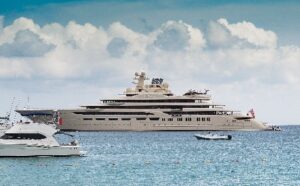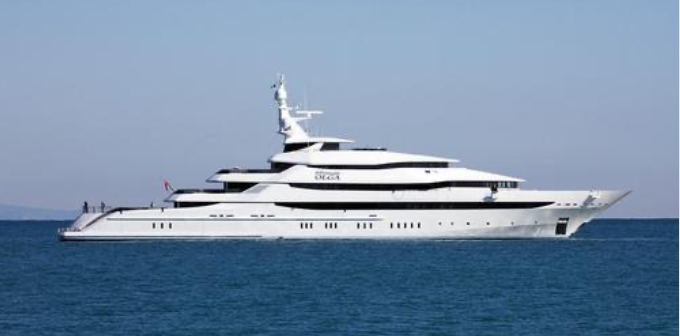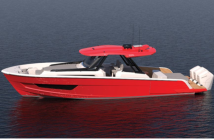The U.S. and many European nations are seizing Russian oligarchs’ megayachts as part of the sanctions imposed after the Russian invasion of Ukraine.
So far, authorities have seized (or tried to seize) oligarchs’ yachts in France, Italy and Germany, among other places. They are acting under both European Union and American sanctions. Addressing the oligarchs in his State of the Union speech, President Biden said “We are joining our European allies to find and seize your yachts, your luxury apartments, your private jets. We are coming for your ill-gotten gains.”
The French Customs Service made one of the first seizures, as the 289-foot Amore Vero prepared to leave the Port La Ciotat on the Cote D/Azur. The yacht is owned by Igor Sechin, the CEO of the Russian oil giant Rosneft and a former KGB officer (like Russian President Vladimir Putin) who’s often described, kindly, as Putin’s deputy, and unkindly as Darth Vadar.
Amore Vero (pictured at top) arrived at the French port on Jan. 3 for repairs. The French customs people said they were making a customs check on March 2 and found that the yacht was “taking steps to sail off urgently” without having the repairs completed. They seized it.
Sechin, 61, is one of 26 Russian oligarchs sanctioned by the EU. He bought the yacht, with two swimming pools and seven guest cabins, in 2012 for $120 million and named it St. Princess Olga (after his wife). She used it often, visiting the Maldives and even Vietnam, as well as Italy, France and Germany, before she ran off with an Italian race car driver. At that point Sechin divorced her and changed the yacht’s name to Amore Vero (or True Love).
Both the U.S. and EU face many problems in seizing oligarchs’ property, primarily establishing who owns what. Over many years the oligarchs have been able to shelter their yachts, real estate and planes under shell companies, with overseas registrations, making the true ownership hard to trace.

That is the case with the 512-foot long Dilbar, one of the largest yachts in the world (pictured above). The U.S. Treasury says Dilbar is owned by Alisher Usmanov, 68, one of Putin’s inner circle, a business magnate, and an early investor in Facebook.
Usmanov bought Dilbar for $648 million in 2016; at that time it was the largest yacht in the world in terms of volume. Built by Lürssen, it has two helipads, berths for 130 guests and an 82-foot-long swimming pool. Operating costs are $60 million a year.
Dilbar has been docked in Hamburg, Germany, since last October for a refit. Last week, German media reported that it had been seized, but the government said no; it could not confirm that Usmanov owned it (even though it is named for his mother). In fact Dilbar is flagged in the Cayman Islands and registered to a holding company in Malta.
In Italy, police seized the Lady M,a 215-foot yacht belonging to Alexey Mordashov, a Russian steel magnate, in the port of Liguria. Built in 2013 by Palmer-Johnson, the yacht is worth $65 million. For his part, Mordashov protested that “I have absolutely nothing to do with the current geopolitical tensions, and I don’t understand why the EU has imposed sanctions on me.”
The Italian police also seized Lena, a 132-foot yacht built in 2010 by Sanlorenzo, in Sanremo. It is owned by Genady Tichenko, who has close ties to Putin and runs a commodities trading company. Lena is worth about $54 million.
Meanwhile, Putin moved his own yacht, Graceful, from Hamburg, where it was having a refit, just before the Russian invasion of Ukraine; it now is safe from seizure in the Russian port of Kaliningrad. (Kaliningrad is a little slice of Russian territory surrounded by Poland and Lithuania.) The 262-foot yacht has a 50-foot indoor swimming pool; it’s worth $100 million.
Other Russians are moving their yachts to safe havens. Indeed, a mini-fleet of megayachts is heading for the Maldives, where they are safe from seizure. But with the crash of the ruble and the Russian stock market, there is some conjecture that at least some of them may be up for sale soon, at bargain-basement prices.
(In case you’re wondering, do svidaniya means good-bye in Russian.) Read more:




